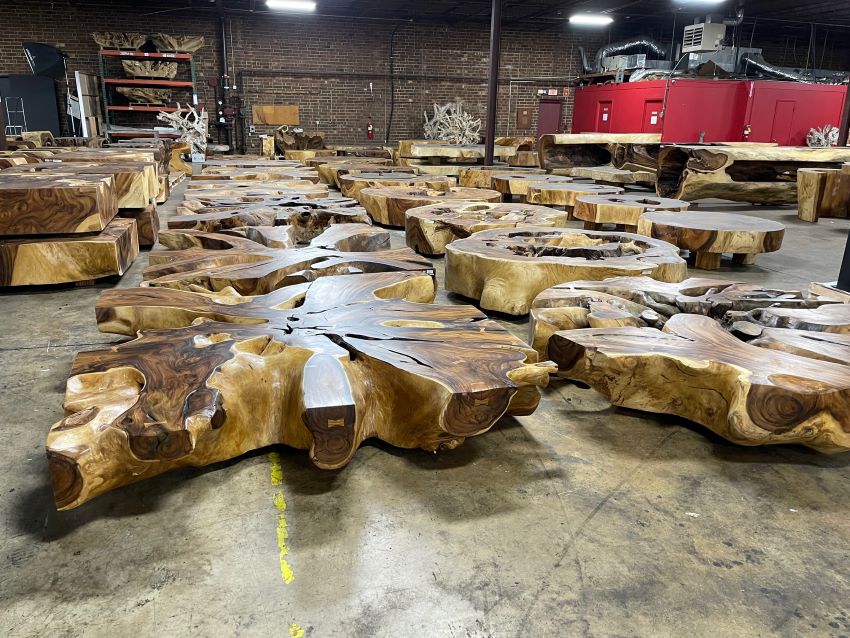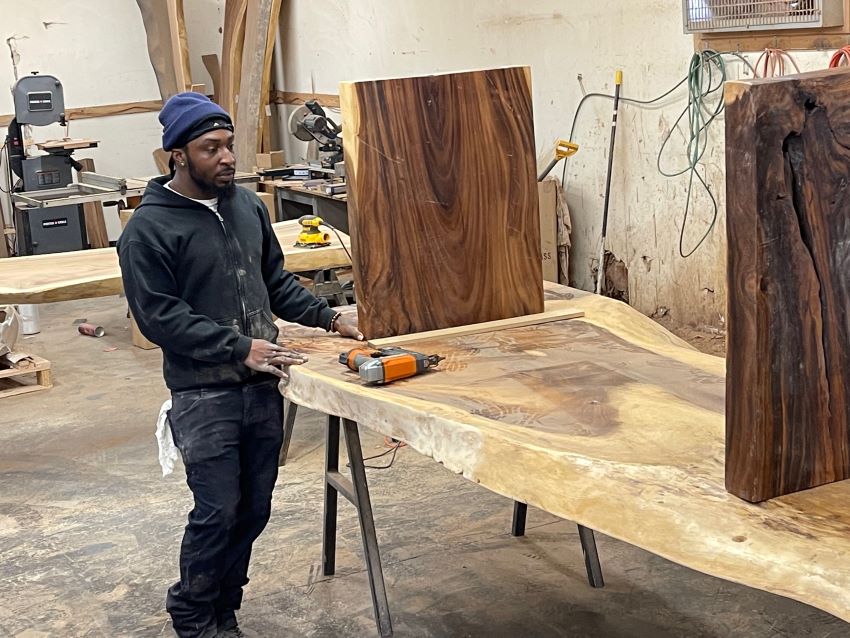Company invests heavily in inventory to keep its flow of products available to dealers, designers and consumers
HIGH POINT — If furniture, art and accessories resource Phillips Collection could link one major strategy to its success over the past couple of years during the pandemic, it would most certainly be its investment in inventory.
In fact it was inventory that not only helped the company see double-digit growth in the past couple of years, it also helped the company to fine tune its furniture assortment closer to what customers were looking for in their respective markets.
“Pre-pandemic, we were sitting on a lot of inventory, and a portion of that was slow moving or discontinued product,” said Jason Phillips, vice president, told Home News Now. “With such a high demand for furnishings these last two years, we have sold through not only our bestsellers, but also a great deal of our older inventory.”

Today, he said, the company is “packed to the brim” with product that is closer to what its customers — designers and retailers alike — want.
“The enormous demand for merchandise has allowed us to reposition our assortment with our best foot forward,” he said.
Phillips declined to reveal its specific inventory levels current in its five buildings in High Point totaling around 400,000 square feet. He also was hesitant to reveal the company’s specific growth other than to say that it has been in the double digits the past two years.
“While we all experienced a drop in early 2020 when the pandemic hit, we quickly recovered and experienced double-digit growth that year. It was the best year in the company’s history,” he said of sales at the time, noting that things have gotten even better since. “2021 was another year of exciting growth that was well into the double digits. We ended last year with the highest sales we’ve ever achieved.”
Demand was so strong, he noted, that last year would have been better if the company had even higher inventory levels for its furniture line, which is roughly a third of its business.
Founded in 1983, Phillips Collection was based in New York for its first 20 years, establishing itself as a go-to resource for furniture, accessories, sculptures, wall décor, lighting and outdoor furniture. The company moved to High Point in early 2002, occupying about 50,000 square feet on Kivett Drive.

Around 2010 it purchased the former Rose Furniture building, which today houses about 160,000 square feet of offices and warehouse space on several floors. It also has four other buildings in the area which comprise the balance of its 400,000 square feet of space.
Having such dedicated space helps explain the importance warehousing plays in its business model.
Phillips Collection is not alone in its investments in inventory. Indeed, having inventory during the pandemic has often separated the strong players from weaker ones in servicing retail customers.
But for Phillips Collection, it’s probably been a trickier equation than it has been for most, as its line is made up of one of a kind pieces crafted from solid slabs of chamcha wood, which at 80% represents by far the largest species used in its dining tables, accent and occasional table lineup, with teak and other species indigenous to the Far East comprising the balance.
The company primarily sources and develops its line from the Philippines and Thailand as well as Indonesia, China, Mexico Brazil and India. It imports the raw wood for seating, table tops and bases from these countries and does most of the final finishing and assembly in High Point.
These wood species, most notably the shapes and wood grain patterns are so unique, you can’t find another one exactly like them in nature. Thus each table top and base has its own distinct makeup and form, much like a person’s face or fingerprint.

Pieces that also include desks, consoles and side tables, often incorporate many different parts of the tree, from the root ball and base to the trunk. The line also incorporates mixed media elements such as metal, acrylic used as legs, for example.
In many cases, a customer sees a particular item they like in the showroom, often buying it right off the floor.
In fact the company sells many goods at market, putting sold tags on each item purchased at the show during the day. Those pieces are then moved out of the space and replenished with other items at night for the next day at market.
But the company sells much more than what it shows at market and that’s where the investment in inventory for its one-of-a-kind pieces comes in.
Today the warehouses in High Point are full of table tops and bases the vast majority of which are not sold orders, Phillips explains, noting that the furniture side of the business continues to grow, particularly among higher-end retailers that he said “are all starting to invest in us as a furniture resource. They are all big accounts.”
Investing in such one of a kind pieces, which can have price tags of $600 on a cocktail table to as much as $15.000 on a dining table could be viewed as a risky venture.
“But once we floor it and it sells, we are selling with repeat business on higher ticket items,” Phillips said. “It’s almost like taking a leap of faith … because this is different. But at Phillips, we are all about being different. We are not even on trend because we don’t like to think of ourselves as trendy. We are celebrating nature – it’s an exquisite natural form – when will that ever go out of style?”

The company is also investing in other areas of the business. Earlier this year it named Serena Martin as director of marketing, a new position. Her role is to oversee major marketing initiatives such as branding, website, print and digital advertising, content management, email marketing and engaging and collaborating with the design community, which represents more than 60% of the company’s business, not including in-house designers working on projects with clients of brick and mortar retailers.
Martin noted that another area where the business is growing is advanced digital tools and technology.
“This allows us to purchase smarter, spotting trends and forecasting accordingly,” she said. “Clean data allows us to gain better insights and analytics for sales and marketing.” In addition, she said, the company is investing in new innovations in product development across its entire line.
“We also have an incredible ERP system that allows us to work very quickly with our inventory and get the product to the customers as fast as possible,” she added. “We are very nimble.”
Challenges remain, including persistent high freight rates from Asia, which impact the cost of flowing goods. But the company said it has only raised prices once in the past year, with the hope that it can minimize the impact on dealers moving forward. Fuel prices averaging about $4.85 per gallon for diesel fuel are another cost factor.
“In the last two years, the biggest pressure has been container pricing,” Phillips said. “But on the domestic side it’s the price of gas right now.”
“Certainly, we are a company that has rarely raised our prices over the years, and our increased volume has supported the potential of lost revenues from higher materials costs,” he added. “So we have always absorbed that as much as possible, although some new collections maybe came in at a higher margin.”
Despite the cost pressures moving forward, Phillips said he remains optimistic for the company’s growth prospects in the year ahead, particularly as the company expands with existing customers and adds new ones to the mix.
“I think as a small-to-medium-sized company, we have to be optimistic that there is a big piece of the pie for us,” he said. “By doing things better and exposing our product to a larger audience, the best thing we could ever do is invest in inventory and design. So we are not going to shy away from aggressive purchasing and all the strategies we have in place once the product arrives, including how we market it with new areas of business we are trying to develop.”
“Furniture will continue to be a large part of our business overall, he added. “Our Origins Collection, consists of a lot of furniture and is a great collection for our company, followed by our dimensional wall art and wall decor collections. Then we have our vast assortment of accessories and sculptures. We offer variety and many different resources for each audience.”





